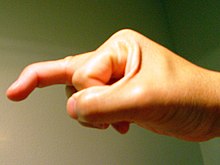Hammer finger
| Classification according to ICD-10 | |
|---|---|
| M20.0 | Deformity of one or more fingers |
| Q74.0 | Other congenital malformations of the upper extremity (s) and shoulder girdle |
| ICD-10 online (WHO version 2019) | |
The constant flexed position of the end joint of a finger is referred to as the hammer finger. The cause of this phenomenon can be both congenital (in some forms of camptodactyly ) and acquired (e.g. as a sports injury, "baseball finger"). In the acquired shape, after the extensor tendon of the distal phalanx is torn out, the base of the finger becomes thickened and this part of the finger is permanently flexed . In the vast majority of cases, a hammer finger does not need to be operated on. In many cases (there are exceptions) it is possible to achieve a good result through consistent immobilization (6–8 weeks) with a Stack splint .
Web links
Individual evidence
- ↑ Alphabetical directory for the ICD-10-WHO version 2019, volume 3. German Institute for Medical Documentation and Information (DIMDI), Cologne, 2019, p. 348
